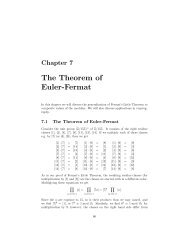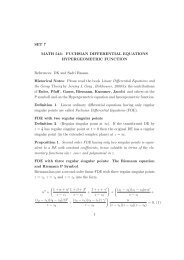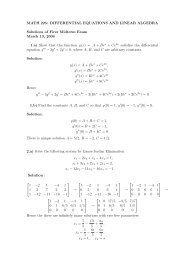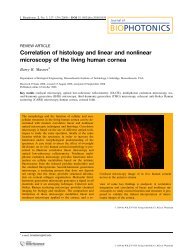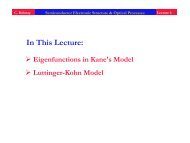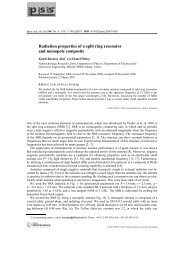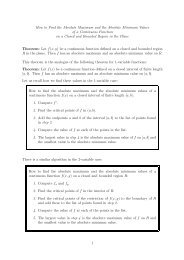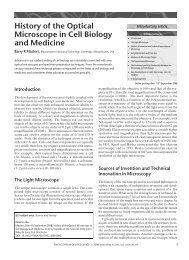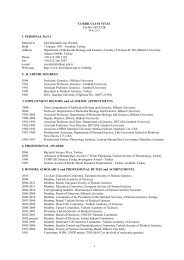Introduction to the English Edition of Hilbert's Zahlbericht
Introduction to the English Edition of Hilbert's Zahlbericht
Introduction to the English Edition of Hilbert's Zahlbericht
Create successful ePaper yourself
Turn your PDF publications into a flip-book with our unique Google optimized e-Paper software.
Genus <strong>the</strong>ory has changed dramatically since it was created by Gauss (who himself<br />
followed in <strong>the</strong> footsteps <strong>of</strong> Euler and Lagrange). 21 Given an extension K/k <strong>of</strong> number<br />
fields, we can define <strong>the</strong> genus class group <strong>of</strong> K as <strong>the</strong> fac<strong>to</strong>r group <strong>of</strong> <strong>the</strong> ideal class<br />
group <strong>of</strong> K corresponding by class field <strong>the</strong>ory <strong>to</strong> <strong>the</strong> extension F K/K, where F is <strong>the</strong><br />
maximal abelian extension <strong>of</strong> k such that F K/K is unramified. Genus <strong>the</strong>ory in Hilbert’s<br />
<strong>Zahlbericht</strong> is <strong>the</strong> special case where K/k is a Kummer extension <strong>of</strong> prime degree ℓ, with<br />
k = Q(ζℓ) a regular cyclo<strong>to</strong>mic field.<br />
Whereas Kummer, in <strong>the</strong> tradition <strong>of</strong> Gauss and Dirichlet, used <strong>the</strong> power residue<br />
symbol <strong>to</strong> define genera, 22 Hilbert built his <strong>the</strong>ory on <strong>the</strong> norm residue symbol. Using<br />
<strong>the</strong> concept <strong>of</strong> fac<strong>to</strong>r groups (which Hilbert is so successful in avoiding as a <strong>the</strong>oretical<br />
notion—see below), his definition 23 boils down <strong>to</strong> <strong>the</strong> following: Let ℓ be an odd prime,<br />
k a number field containing <strong>the</strong> group µℓ <strong>of</strong> ℓ-th roots <strong>of</strong> unity, assume that <strong>the</strong> class<br />
number h <strong>of</strong> k is not divisible by ℓ, and let K = k( ℓ√ µ ) be a Kummer extension <strong>of</strong> k;<br />
assume moreover that <strong>the</strong> class number h <strong>of</strong> k is not divisible by ℓ and let h∗ be an integer<br />
such that hh∗ ≡ 1 mod ℓ. Let p1, . . . , pt denote <strong>the</strong> primes <strong>of</strong> k that ramify in K/k, and<br />
define a homomorphism X : k × −→ µ t ℓ by <strong>the</strong> rule α ↦−→ { α, µ<br />
α, µ<br />
, · · · , }. Let X(E)<br />
p1<br />
pt<br />
denote <strong>the</strong> image <strong>of</strong> <strong>the</strong> unit group E <strong>of</strong> k × under X, and define <strong>the</strong> homomorphism χ<br />
from <strong>the</strong> group <strong>of</strong> invertible ideals <strong>of</strong> K <strong>to</strong> µ t ℓ /X(E) by putting χ(A) = X(α) · X(E),<br />
where α is a genera<strong>to</strong>r <strong>of</strong> <strong>the</strong> principal ideal NK/kAhh∗. This is clearly well defined, and<br />
ideals <strong>of</strong> K having <strong>the</strong> same image under χ are said <strong>to</strong> belong <strong>to</strong> <strong>the</strong> same genus. The<br />
kernel <strong>of</strong> χ is called <strong>the</strong> principal genus. The fact that norms are norm residues implies<br />
that each genus is a collection <strong>of</strong> ideal classes.<br />
This definition is also valid for ℓ = 2 and equivalence in <strong>the</strong> usual sense if one is<br />
willing <strong>to</strong> use infinite primes; <strong>the</strong>se were, however, introduced by Hilbert only after his<br />
<strong>Zahlbericht</strong> was written. 24<br />
The main problem <strong>of</strong> genus <strong>the</strong>ory was <strong>to</strong> find a formula for <strong>the</strong> number <strong>of</strong> genera.<br />
Traditionally, this is accomplished by proving a lower and an upper bound which are<br />
called <strong>the</strong> first and <strong>the</strong> second inequality, respectively (<strong>the</strong>se are special cases <strong>of</strong> <strong>the</strong><br />
corresponding inequalities <strong>of</strong> class field <strong>the</strong>ory).<br />
To see <strong>the</strong> connection <strong>of</strong> genus <strong>the</strong>ory with <strong>the</strong> general reciprocity law, recall Gauss’s<br />
second pro<strong>of</strong> <strong>of</strong> <strong>the</strong> quadratic reciprocity law: Let t denote <strong>the</strong> number <strong>of</strong> distinct primes<br />
dividing <strong>the</strong> discriminant <strong>of</strong> k. Then <strong>the</strong> first inequality <strong>of</strong> genus <strong>the</strong>ory says that <strong>the</strong>re<br />
are at most 2 t−1 genera, i.e., that # Cl + (k)/Cl + (k) 2 ≤ 2 t−1 . Using this information, a<br />
special case <strong>of</strong> <strong>the</strong> quadratic reciprocity law can be proved as follows. Let p ≡ 1 mod 4<br />
and q be odd primes and assume that (p/q) = +1. Then q splits in k = Q( √ p ), and by<br />
21 See e.g. G. Frei, On <strong>the</strong> development <strong>of</strong> <strong>the</strong> genus group in number fields, Ann. Sci. Math. Quebec 3<br />
(1979), 5–62. For modern presentations <strong>of</strong> genus <strong>the</strong>ory see <strong>the</strong> books <strong>of</strong> D. Zagier [Zetafunktionen und<br />
quadratische Körper. Eine Einführung in die höhere Zahlen<strong>the</strong>orie, Berlin, Heidelberg, etc.: Springer,<br />
1981] for <strong>the</strong> quadratic and A. Fröhlich [Central extensions, Galois groups, and ideal class groups <strong>of</strong><br />
number fields, AMS 1983.] for <strong>the</strong> general case.<br />
22 E.E. Kummer, Über die allgemeinen Reciprocitätsgesetze der Potenzreste, Collected Papers I, 673–<br />
687, in particular p. 678<br />
23 See <strong>Zahlbericht</strong>, §66 and §84 for quadratic fields and equivalence in <strong>the</strong> usual and strict sense, re-<br />
spectively, and §150 for Kummer fields.<br />
24 D. Hilbert, Über die Theorie der relativ-Abelschen Zahlkörper, Gesammelte Abhandlungen I, 483–509,<br />
in particular §6.<br />
7



